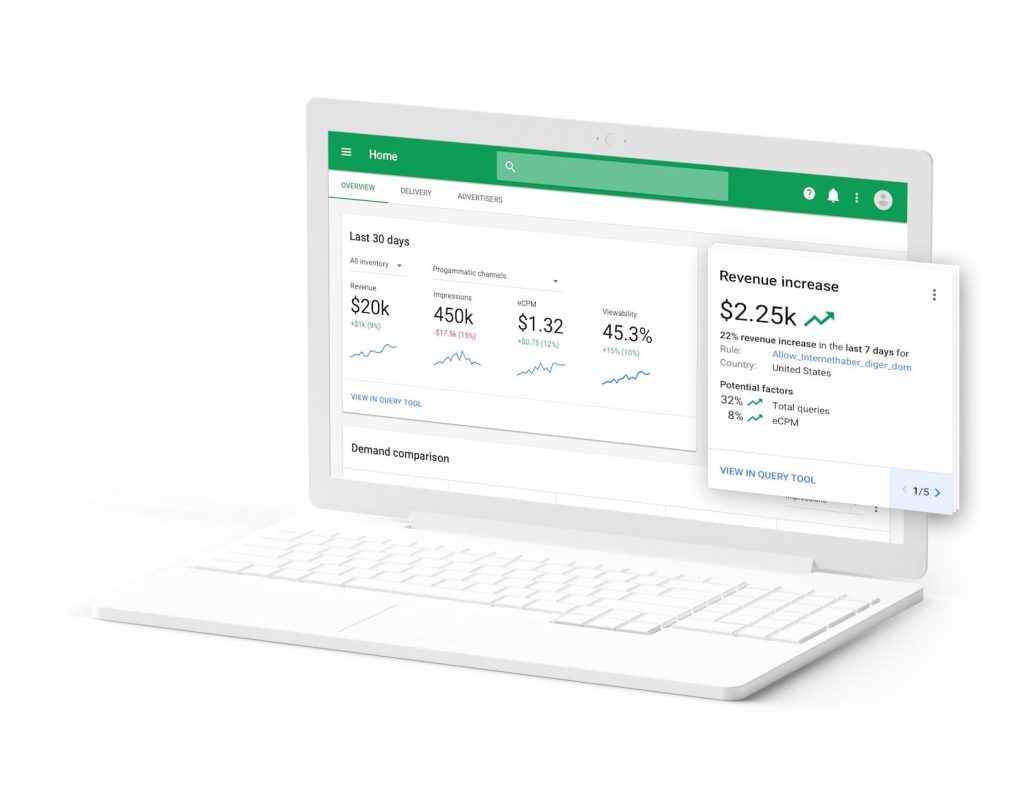Google Ad Manager, a fusion of Google’s previous DoubleClick services, stands as a beacon of efficiency in the bustling digital marketplace. With new websites and apps emerging daily, the need for a robust and multifaceted ad management system has never been more evident. Google Ad Manager rises to this challenge effortlessly. It not only simplifies the complex world of ad placements but also enhances ad relevance and boosts revenue potential through its advanced features. This exploration into Google Ad Manager will reveal how it functions and the array of benefits it offers, positioning it as an essential tool for mastering the nuances of online advertising.
What is Google Ad Manager?

Google Ad Manager is a tool designed for digital publishers, combining the essentials of ad serving, management, and programmatic ad exchange in one place. It’s where publishers go to manage their ads across websites, apps, and videos. This tool excels in making ad management smoother and more efficient, allowing for targeted ad delivery and real-time ad revenue optimization. It’s not just about placing ads; it’s about placing them smartly and effectively.
With Google Ad Manager, publishers can sell ad space in an automated auction environment, ensuring they get the best value while delivering relevant ads to their audience. it’s packed with analytics features, giving publishers valuable insights into how their ads are performing. Google Ad Manager is a solution for modern digital ad management, streamlining the process and boosting the effectiveness of online advertising strategies.
Key Features of Google Ad Manager

1. Responsive Ad Units
These ad units intelligently adapt to different screen sizes and orientations, ensuring that ads are always displayed optimally. Whether a user is on a desktop, tablet, or smartphone, the ads adjust in size and layout to fit the screen, enhancing readability and engagement. This adaptability not only improves the user experience but also increases the likelihood of ad interaction, thereby potentially boosting ad performance and revenue.
2. Ad Breaks for Video Content
This tool enables publishers to insert ad breaks at strategic points in their video content, balancing monetization with viewer experience. It’s especially crucial for streaming platforms where maintaining viewer engagement is key. These ad breaks are managed to ensure they align well with the content, avoiding disruption and enhancing the viewing experience. This leads to a more natural and enjoyable viewing experience, while also maximizing ad visibility and revenue potential in video content.
3. Custom Reporting Capabilities
This feature allows for deep dives into specific data sets, offering insights into ad performance, audience demographics, revenue trends, and more. Publishers can filter, sort, and analyze the data to uncover valuable information that informs strategic decisions. By having access to customized reports, publishers can identify opportunities for improvement, track progress over time, and fine-tune their ad strategies for maximum impact and efficiency.
4. Inventory Management
This tool enables the categorization and segmentation of ad inventory, allowing for more strategic selling and reporting. Publishers can group their ad spaces based on factors like website sections, audience demographics, or content type. This detailed segmentation facilitates targeted ad placement, ensuring that the right ads reach the most relevant audience segments. It enhances the value of ad inventory by aligning it more closely with advertiser needs, leading to more effective monetization and improved reporting accuracy.
5. Multiple Demand Sources Integration
By supporting the integration with a variety of demand sources, including direct advertisers and numerous ad networks, this functionality creates a competitive environment for ad spaces. It opens up the advertising inventory to a broader market, inviting bids from a diverse range of advertisers. This competition not only drives up the potential revenue for each ad impression but also gives publishers the flexibility to choose the most suitable and lucrative ads for their audience, ensuring a more effective and profitable ad strategy.
6. User-Friendly Interface
This streamlined interface demystifies the intricacies of ad operations, offering clear navigation and understandable tools. Whether you’re a seasoned ad manager or new to the field, the platform’s design minimizes the learning curve and enhances efficiency. It enables users to quickly set up, manage, and optimize their ad campaigns without getting bogged down by technical complexities, making the entire process smoother and more user-friendly.
7. Ad Quality Controls
These controls are crucial for maintaining the integrity and appeal of a publisher’s site or app. By setting strict quality standards and parameters, publishers can filter out inappropriate or low-quality ads, ensuring that only content that aligns with their standards and audience expectations is displayed. This not only protects the publisher’s brand reputation but also enhances the user experience, as viewers are more likely to engage with relevant ads of high quality. The feature is essential for building trust and maintaining a positive relationship with the audience.
8. Flexible Pricing Models
Supporting diverse pricing models like Cost Per Mille (CPM), Cost Per Click (CPC), and Cost Per Action (CPA), gives publishers the versatility to choose the best monetization strategy for their specific content and audience. This flexibility is crucial in dynamic digital advertising, where the effectiveness of ads can vary greatly depending on the context and audience. Publishers can tailor their pricing strategy to align with their advertising goals, whether they’re aiming for broad reach, high engagement, or direct consumer action, ensuring optimal revenue from their ad inventory.
9. Header Bidding Support
This feature allows publishers to simultaneously receive bids from multiple ad exchanges before making ad server calls. This process ensures that publishers can access the highest possible bids for their ad inventory, increasing revenue potential. Header bidding democratizes the ad buying process, as it gives all advertisers equal opportunity to bid on ad inventory, leading to fair market value pricing. For publishers, this means more control over ad inventory and maximized ad revenues, as they’re not limited to a single demand source.
10. Enhanced Ad Security
This tool employs advanced security measures to safeguard against ad fraud, one of the biggest challenges in digital advertising. Ensuring that ad transactions are secure and legitimate, protects both publishers and advertisers from fraudulent activities that can undermine the effectiveness and credibility of their campaigns. This security feature not only helps in maintaining high standards of ad quality but also instills confidence among advertisers and publishers, ensuring a safe, reliable, and transparent advertising environment.
Benefits of Using Google Ad Manager

1. Enhanced Creativity with Innovative Ad Formats
This advantage allows the inclusion of engaging formats like interactive and rich media ads, revolutionizing the way audiences interact with content. It’s a step beyond mere visual appeal, fostering meaningful engagement and enhancing the overall user experience. For advertisers, this translates into a unique and impactful way to convey their messages, ensuring that ads are not just seen but also remembered and acted upon.
2. Expansive Reach with Global Market Access
This global connectivity links publishers with a vast, diverse advertiser network worldwide, significantly widening their advertising scope. Such extensive reach is more than just a revenue booster; it brings a rich variety of advertising content to the platform, catering to a global audience and enriching the user experience with a multicultural touch.
3. Support through Community and Network
This benefit encompasses a wide-reaching community of users and an extensive array of Google support resources, including expert forums, training materials, and customer service. This network ensures publishers are well-equipped to navigate the platform’s features, stay abreast of the latest industry trends, and optimize their ad strategies effectively. It’s a support system that not only resolves technical queries but also fosters continuous learning and growth in the realm of digital advertising.
4. Granular Control Over Ad Decisioning
This control enables publishers to define specific rules and preferences for ad displays, aligning them perfectly with their business goals and audience needs. This level of precision in ad placement ensures that each ad not only generates revenue but also resonates with the audience, enhancing user engagement and satisfaction. It’s a strategic advantage that allows for tailored ad experiences, boosting the overall effectiveness of advertising campaigns.
5. Ad Blocking and Safe Ad Load
Publishers can proactively filter out inappropriate or low-quality ads, ensuring only compliant and suitable content reaches their audience. This safeguarding of ad quality is vital in maintaining a positive user experience and upholding the integrity of the publisher’s platform. It’s a crucial aspect that builds audience trust and loyalty, as viewers are assured a safe and enjoyable browsing experience.
6. Integration with Google’s Ecosystem
This integration allows for a smooth combination of ad management with other Google tools, like Google Analytics, enabling a comprehensive understanding of audience behaviors and ad performance. Such insights are invaluable for making informed decisions about ad strategies. This cohesive approach enhances the effectiveness of digital advertising, improving both the user experience and the success rate of ad campaigns.
7. Inventory Management
This centralized approach simplifies the complex process of tracking and optimizing various ad types, such as display, mobile, video, and programmatic ads. For publishers and advertisers, this means easier monitoring and adjustment of ad strategies, ensuring optimal use of every ad space. The result is a more efficient ad management process, leading to better utilization of resources and enhanced revenue opportunities.
8. Dynamic Allocation
This feature intelligently assesses the performance of various ad sources and selects the one likely to generate the highest revenue. Such smart decision-making not only maximizes revenue for publishers but also guarantees effective use of ad spaces. By adapting to market conditions and advertiser bids in real-time, Dynamic Allocation optimizes the revenue potential of each ad impression, enhancing the overall profitability of ad campaigns.
9. Advanced Forecasting Tools
These tools analyze trends and data to anticipate ad space availability, aiding in the strategic planning and selling of ad inventory. With such predictive insights, publishers can make more informed decisions on when and at what price to sell their ad space. This proactive approach maximizes the utility and profitability of ad inventory, keeping publishers ahead in the competitive advertising market.
10. Yield Management
This feature aids in navigating the complexities of selling ad inventory, whether directly or through programmatic channels. It provides tools for detailed analysis and optimization of sales strategies, ensuring the highest possible return on ad spaces. This balance between direct and programmatic sales is crucial in enhancing overall ad revenue. Publishers can maximize the value of each ad slot, aligning their strategies with market trends and opportunities for better financial outcomes.
Conclusion
Google Ad Manager is an indispensable ally in the intricate landscape of online advertising. It stands out with a broad spectrum of functionalities that revolutionize ad management and revenue generation. This platform makes advertising seamless, from targeting the right audience to delivering ads across diverse digital mediums. Beyond these capabilities, it excels in providing detailed analytics, efficient inventory management, and automated ad optimization.
































































